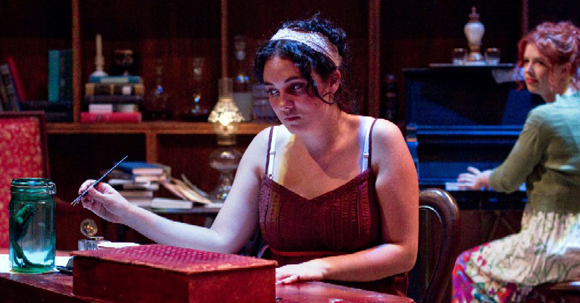| Sun | Mon | Tue | Wed | Thu | Fri | Sat |
|---|---|---|---|---|---|---|
| 1 | 2 | 3 | 4 | 5 | ||
| 6 | 7 | 8 | 9 | 10 | 11 | 12 |
| 13 | 14 | 15 | 16 | 17 | 18 | 19 |
| 20 | 21 | 22 | 23 | 24 | 25 | 26 |
| 27 | 28 | 29 | 30 | 31 |
CATEGORIES
RECENT ENTRIES
BLOG ROLL
Origin story
Playwright Emily Dendinger, AM'08, retells how Mary Shelley conceived of her Frankenstein.

Last Friday I went to see Hideous Progeny, a world-premiere play by Emily Dendinger, AM'08, put on by LiveWire Chicago Theatre company. I ran into Dendinger outside the Storefront Theater on Randolph Street—she was waiting for some friends from Indiana who'd come into town to see the show, and she was worried they wouldn't find the theater. Wearing large, black frames instead of her usual contact lenses, Dendinger discussed the show's reviews: TimeOut Chicago loved it—a comparison to Tom Stoppard!—but Leah A. Zeldes, at ChicagoTheaterBlog.com, found it "riddled with historical anachronisms."
Started as her master's thesis at the U of C (Dendinger was in the Master of Arts Program in the Humanities), Hideous Progeny, which runs through September 26, recounts the genesis of Mary Shelley's Frankenstein story. At a vacation home in Switzerland, Lord George Byron challenged his guests—Percy Bysshe Shelley, Mary Shelley (then Mary Wollstonecraft Godwin), Byron's private physician John William Polidori, and Mary's stepsister Jane "Claire" Clairmont—to a competition of who could write the best ghost story (spoiler alert: Mary wins). In the play, the actors wear contemporary clothing—the actress playing Mary has a nose ring, for example—and none of them speaks with British accents. But the story, which Dendinger infuses with quotes from real diaries, letters, and poetry from the historical figures, is enjoyable enough to make the historical inconsistencies (almost) irrelevant. Call it "creative license."
Ruth E. Kott, AM'07
Photo by John W. Sisson Jr.
September 14, 2010
